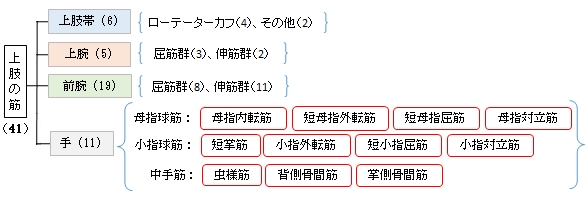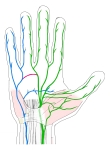虫様筋(手) (ちゅうようきん、英:lumbrical muscles)
・ 概 要 |
・ 作 用 |
・ イラスト掲載サイト |
|
・ イラスト |
・ 神経 / 脈管 |
||
・ 起始 / 停止 |
・ Wikipedia |
![]()



■ 二頭筋に関して ■
1. 「日本人体解剖学 (上巻) 」 ⇒ 第2~第4虫様筋を二頭筋
「第1虫様筋は1頭で第2指にいく深指屈筋腱の橈側から、第2~第4虫様筋はそれぞれ2頭を持って、第2~第5指に至る深指屈筋腱の対向側から起こる。」
2. 「プロメテウス解剖学アトラス」 ⇒ 第3および第4虫様筋 を「しばしば2頭で起始し」としている。
3. 「船戸和也のHP」では頭数に関する記述は一切見られない。
※Wikipediaでは「第3および第4虫様筋」に「bipennate(双翼状?)」という語を用いている。
![]()
以下は「船戸和也のHP」の解説文となる。
「第4つの虫様筋は、各々深指屈筋の腱の橈側から起こり、そのため深指屈筋の収縮中緊張する。虫様筋は深横中手靱帯の掌側を遠位に向かい、したがって指の対応する基節関節の屈曲軸の掌側を走る。それらの腱は橈側から指背腱膜に入る。腱停止部の近位線維は基節骨の背側面をほぼ横断するのに対し、遠位線維は中節骨と末節骨の背側面を斜走する。」
また、「筋肉.guide」では以下のように解説している。
「(途中略)虫様筋は、細かい物を取ろうとしたり、つまんだりする動作の中で発揮されます。この筋肉を触診するには、物をつまむ動作をして、更に力を入れます。すると、手掌側でこの筋肉の筋腹が緊張したり弛緩したりをを確かめることが出来ます。ただし、他の筋肉も働きますので、この筋肉のみを確かめることは非常に困難です。」
![]()
![]()
【 起 始 】 : 深指屈筋の停止腱
・1頭の場合は深指屈筋の停止腱の橈側から起始
・2頭の場合は深指屈筋の停止腱の相対する側からも起始
【 停 止 】 : 第2~第5基節骨の外側縁の指背腱膜
![]()
・第2~第5指の
中手指節関節 (MP関節)の屈曲
指節間関節 (DIP,PIP関節)の伸展
![]()
・ 神 経 : 第1、第2虫様筋 : 正中神経
第3、第4虫様筋 : 尺骨神経深枝 (C8,Th1)
※Wikipediaによると、上記の神経支配(2:2)の確率はだいたい60%で、(1:3)や(3:1)になることも、それぞれ20%ほどあるとのこと。
・ 脈 管 : 浅掌動脈弓
※Wikipediaでは上記の他に、

|
![]()
The lumbricals are intrinsic muscles of the hand that flex the metacarpophalangeal joints, and extend the interphalangeal joints.
The lumbrical muscles of the foot also have a similar action, though they are of less clinical concern.
【Structure】
The lumbricals are four, small, worm-like muscles on each hand. These muscles are unusual in that they do not attach to bone. Instead, they attach proximally to the tendons of flexor digitorum profundus, and distally to the extensor expansions. The first and second lumbricals are unipennate, while the third and fourth lumbricals are bipennate.
# |
Form |
Origin |
Insertion |
First |
It originates from the radial side of the most radial tendon of the flexor digitorum profundus (corresponding to the index finger). |
It passes posteriorly along the radial side of the index finger to insert on the extensor expansion near the metacarpophalangeal joint. |
|
Second |
unipennate |
It originates from the radial side of the second most radial tendon of the flexor digitorum profundus (which corresponds to the middle finger). |
It passes posteriorly along the radial side of the middle finger and inserts on the extensor expansion near the metacarpophalangeal joint. |
Third |
One head originates on the radial side of the flexor digitorum profundus tendon corresponding to the ring finger, while the other originates on the ulnar side of the tendon for the middle finger. |
The muscle passes posteriorly along the radial side of the ring finger to insert on its extensor expansion. |
|
Fourth |
bipennate |
One head originates on the radial side of the flexor digitorum profundus tendon corresponding to the little finger, while the other originates on the ulnar side of the tendon for the ring finger. |
The muscle passes posteriorly along the radial side of the little finger to insert on its extensor expansion. |
【 語 句 】
・ intrinsic : 固有の ・ flex : 曲げる ・ metacarpophalangeal joint : 中手指節関節 ・ extend : 伸ばす ・ interphalangeal joint : 指節間関節 ・ worm-like : ミミズ状 ・ flexor digitorum profundus : 深指屈筋 ・ extensor expansions : 指背腱膜? ・ unipennate : 単翼状 ・ bipennate : 双翼状 ・ radial : 橈骨の ・ corresponding to ~ : ~に対応している ・ ulnar : 尺骨の
【Nerve supply】
The first and second lumbricals (the most radial two) are innervated by the median nerve. The third and fourth lumbricals (most ulnar two) are innervated by the ulnar nerve.
This is the usual innervation of the lumbricals (occurring in 60% of individuals). However 1:3 (median:ulnar - 20% of individuals) and 3:1 (median:ulnar - 20% of individuals) also exist. The lumbrical innervation always follows the innervation pattern of the associated muscle unit of flexor digitorum profundus (i.e. if the muscle units supplying the tendon to the middle finger are innervated by the median nerve, the second lumbrical will also be innervated by the median nerve).
【Blood supply】
Four separate sources supply blood to these muscles: the superficial palmar arch, the common palmar digital artery, the deep palmar arch, and the dorsal digital artery.
【Function 】
The lumbrical muscles, with the help of the interosseous muscles, simultaneously flex the metacarpophalangeal joints while extending both interphalangeal joints of the digit on which it inserts. The lumbricals are used during an upstroke in writing.
【 語 句 】
・ median nerve : 正中神経 ・ ulnar nerve : 尺骨の ・ superficial palmar arch : 浅掌動脈弓 ・ common palmar digital artery : 総掌側指動脈 ・ deep palmar arch : 深掌動脈弓 ・ dorsal digital artery : 背側指動脈 ・ interosseous muscles : 骨間筋 ・ simultaneously : 同時に ・ digit : 指 ・ upstroke : 上向きの筆づかい
![]()






